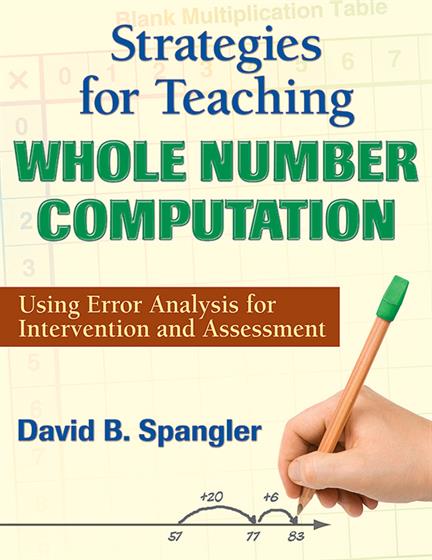
Hands-on, Practical Guidance for Educators
From math,
literacy, equity, multilingual learners, and SEL, to assessment, school counseling,
and education leadership, our books are research-based and authored by experts
on topics most relevant to what educators are facing today.
Strategies for Teaching Whole Number Computation
A proven approach to mathematics teaching that adds up to student success!
This comprehensive resource helps elementary teachers uncover the misconceptions behind students' errors and help students understand and correct their own mistakes. The text's interventions for each error pattern promote teaching for conceptual understanding and are supported by documented academic research. Included are units for addition, subtraction, multiplication, and division, each containing:
- A diagnostic test in a multiple-choice format
- An item analysis table that correlates incorrect test responses with student error patterns
- A detailed section of supporting intervention activities to address specific types of errors
- Practice exercises for students
- Open-ended reflection questions for teachers
- Grade Level: PreK-12, Elementary
- ISBN: 9781412981064
- Published By: Corwin
- Year: 2010
- Page Count: 224
- Publication date: April 10, 2014
Price: $43.95
For Instructors
When you select 'request review copy', you will be redirected to Sage Publishing (our parent site) to process your request.
Description
"This book is a must-have for anyone working to remediate students struggling with math. It gets into the types of misconceptions students have and gives multiple ways to correct them."
—Donna Adkins, First-Grade Teacher
Perritt Primary School, Arkadelphia, AR
"The nuts-and-bolts approach to assessment and error analysis make this book a real tool for everyday use."
—Judith A. Filkins, K–8 Math Curriculum Coordinator
Lebanon School District, NH
A proven approach to mathematics teaching that adds up to student success!
When students make computational errors in mathematics, often the prescribed solution is more drilling. However, by combining error analysis with timely and specific intervention based on conceptual understanding, teachers can get to the cause of students' errors, uncover underlying misconceptions, and help students understand and correct their mistakes. The targeted interventions for each error pattern promote teaching for conceptual understanding and are supported by documented academic research.
David B. Spangler, a school math consultant with more than 35 years of experience, provides a model that focuses on student error patterns in addition, subtraction, multiplication, and division. This book offers targeted instructional strategies based on the five NCTM process standards and includes four units, each containing:
- A diagnostic test in a multiple-choice format
- An item analysis table that correlates incorrect test responses with student error patterns
- A detailed section of supporting intervention activities to address specific types of errors
- Practice exercises for students, with answer keys
- Reflection questions for teachers to use in a professional development setting, workshop, or methods course
With supporting research, a section on "big ideas" in computation and problem solving, and student reproducibles for games and activities, Strategies for Teaching Whole Number Computation promotes a proactive and scaffolded approach to teaching mathematics in a meaningful way.
Key features
- The focus on interventions for struggling students makes it ideal for use in an RTI framework
- Includes many examples of typical error patterns that students make along with interventions that correspond to the errors
- Covers mathematical problems in the areas of addition, subtraction, multiplication, and division that can be used with elementary students who have varied levels of math knowledge and skills
- Each unit includes a diagnostic test
- Author's company, ActiveMath, provides professional development services and workshops to teachers
Author(s)

David B. Spangler
David B. Spangler is the recipient of the 2014 Lee E. Yunker Mathematics Leadership Award, sponsored by the Illinois Council of Teachers of Mathematics. The award honors an Illinois teacher for providing outstanding resources to mathematics teachers. David has devoted his professional career of more than 40 years to mathematics education. He began as a middle-school mathematics teacher in an individualized setting. Later he taught at Triton Community College, where he gained direct experience interacting with struggling students in a developmental math laboratory. Currently he teachers mathematics methods courses through National-Louis University and ActiveMath Workshops, a professional development company he co-founded in 1994 (activemath.com). Some of the methods courses and workshops he facilitates address special needs students, intervention, computation, and error analysis at the elementary level. His workshops are designed to help teachers implement the Common Core State Standards for Mathematics. David has literally worked with thousands of students and teachers during his career.
For many years David has worked as a mathematics textbook editor at the K–12 level. He has authored several books and has written numerous articles for mathematics journals, such as the popular "Cartoon Corner" for Mathematics Teaching in the Middle School.
As an educator, David’s goal has always been to teach mathematics for meaning rather than in a way that promotes rote memorization. Strategies for Teaching Whole Number Computation and Strategies for Teaching Fractions were written to help teachers achieve that goal. David’s other professional goals include exploring ways to teach mathematics through engaging, real-world applications and to explore humorous aspects to mathematics, especially mathematical blunders that illustrate mathematics illiteracy. David is a frequent speaker at conferences of the National Council of Teachers of Mathematics and other professional organizations, addressing teaching mathematics for meaning, teaching mathematics through real-world applications, and teaching mathematics through humor. He also delivers after-dinner talks on the subject of mathematical humor.
David lives with his wife, Bonnie, in Northbrook, Illinois. They have three grown children, Ben, Jamie, and Joey.
Table of Contents
Preface
Acknowledgments
About the Author
A Look at the Academic Research: Intervention in the Mathematics Classroom
Introduction to the Academic Research
Equity and Quality in the Math Classroom
Student Dispositions
Activating Prior Knowledge
Representations
Estimation and Mental Math
Alternative Algorithms
Differentiating Instruction
Instructional Games
Response to Intervention
Questions for Teacher Reflection
Big Ideas in Computation and Problem Solving
The Base-Ten Place-Value System and Multidigit Computation
Actions and Operations
Questions for Teacher Reflection
Unit 1. Addition of Whole Numbers
Diagnostic Test
Item Analysis for Diagnostic Test
Error Patterns & Intervention Activities
Practice Exercises
Questions for Teacher Reflection
Unit 2. Subtraction of Whole Numbers
Diagnostic Test
Item Analysis for Diagnostic Test
Error Patterns & Intervention Activities
Practice Exercises
Questions for Teacher Reflection
Unit 3. Multiplication of Whole Numbers
Diagnostic Test
Item Analysis for Diagnostic Test
Error Patterns & Intervention Activities
Practice Exercises
Questions for Teacher Reflection
Unit 4. Division of Whole Numbers
Diagnostic Test
Item Analysis for Diagnostic Test
Error Patterns & Intervention Activities
Practice Exercises
Questions for Teacher Reflection
Resources for Estimation, Instructional Games, and Follow-Up Activities (Blacklines)
Resources for Addition
Follow-Up Activity: Next Number, Please
Roller Coaster Rounding
Using Front-End Estimation to Check for Reasonableness: Addition
Instructional Game: Keeping Score in Bowling
Resources for Subtraction
Using Front-End Estimation to Check for Reasonableness: Subtraction
Instructional Game: Balance the +/- Number Sentence!
Follow-Up Activity: Editor Error Search (+/-)
Instructional Game: Target Math (+/-)
Resources for Multiplication
Touching on the Facts With Your Fingers
Using Front-End Estimation to Check for Reasonableness: Multiplication
Instructional Game: How Close Can You Get?
Follow-Up Activity: Editor Error Seach (x)
Resources for Division
Using Front-End Estimation to Check for Reasonableness: Division
Using Compatible Numbers to Check for Reasonableness (+, -, x, ÷)
Instructional Game: Balance the x/÷ Number Sentence!
Follow-Up Activity: Abbott and Costello's Number Nonsense
Instructional Game: Target Math (x/÷)
Multiuse Resources (Blacklines)
Play Money
Place-Value Mat for Addition/Subtraction
Place-Value Grids for Addition/Subtraction
Place-Value Grids for Division
Tables for Addition/Subtraction
Tables for Multiplication/Division
Grid Paper (¼ inch)
Answers for Student Materials
Answers for Unit 1: Addition of Whole Numbers
Answers for Unit 2: Subtraction of Whole Numbers
Answers for Unit 3: Multiplication of Whole Numbers
Answers for Unit 4: Division of Whole Numbers
References
Reviews
“I can see this book becoming a very important and seminal piece in mathematics instruction and teaching practice. It allows the instructor to take a proactive and scaffolded approach for teaching students experiencing difficulties in mathematics, and it builds upon the mathematical knowledge of the teacher."Cathy Patterson, Assistant Principal
Evergreen Elementary School, Diamond Bar, CA
“This book is a must-have for anyone working to remediate students struggling with math. It gets into the types of mistakes/misconceptions students have and gives multiple ways to correct them. It is also a great resource for teachers who need a stronger math background."Donna Adkins, First-Grade Teacher
Perritt Primary School, Arkadelphia, AR
"Highly recommended for all K-8 teachers to help all students learn math and be successful! Spangler captures the essence of teaching mathematics to all children through the Response to Intervention focus. This is a very practical and useful math resource for all teachers, including general education teachers as well as special educators."Edna F. Bazik, Mathematics Education Program Coordinator
National-Louis University
“The nuts-and-bolts approach to assessment and error analysis make this a real tool for everyday use in real classrooms."Judith A. Filkins, K-8 Math Curriculum Coordinator
Lebanon School District, NH
“The comprehensive examples and explanations are exemplary. The book contains a goldmine of information, strategies, and interventions. Most teachers do not have error analysis on their radar—they should, as it is critical for informing instruction and facilitating student learning.”Katharine Olson, Assistant Superintendent for Curriculum, Instruction, and Assessment
Northbrook Elementary School District 27, IL
"A wonderful addition to any professional library. All too often when a student makes a computational error, the prescribed remediation is further drilling. Based on recognized cognitive research, this book provides a model that helps the teacher analyze student work for error patterns and then provide timely, targeted, and meaningful intervention. This book provides well-organized, comprehensive strategies to meet the learning needs of all students."Hope Martin, Author/Consultant
ActiveMath Workshop
"This well-designed handbook is for educators whose students struggle with arithmetic operations. It offers valuable assistance to tutors, special educators, and classroom teachers."Sally Moomaw
University of Cincinnati, Ohio
For Instructors
When you select 'request review copy', you will be redirected to Sage Publishing (our parent site) to process your request.

